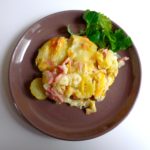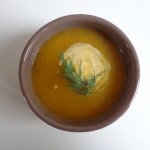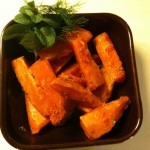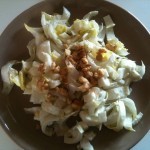 This is a cold-weather dish most commonly encountered in the Alpine ski resorts of eastern France: potatoes, onions, bacon and flavorful reblochon cheese baked together to make a mouth-watering one-dish meal. But tartiflette has become so popular that restaurants from Burgundy to the Pyrenees now serve it. The name derives from a word for potatoes, tartifla, that is used in Italy and Provence — but, oddly, not in Savoie…
This is a cold-weather dish most commonly encountered in the Alpine ski resorts of eastern France: potatoes, onions, bacon and flavorful reblochon cheese baked together to make a mouth-watering one-dish meal. But tartiflette has become so popular that restaurants from Burgundy to the Pyrenees now serve it. The name derives from a word for potatoes, tartifla, that is used in Italy and Provence — but, oddly, not in Savoie…
Tartiflette / Savoyard potato gratin with bacon
According to various culinary sources, the dish was traditionally known in Savoie not as tartiflette but as péla, named for the long-handled pan in which it was cooked over a fire. Things began changing around 30 years ago when the cheesemakers who produce reblochon — a pungent soft cheese made from cow’s milk — decided to try to boost sales of their product. When exactly péla morphed into tartiflette is not clear to me. But judging by my 1969 edition of Le Petit Robert, one of France’s most authoritative dictionaries, today’s word for this very well-known dish had not yet entered the language just 43 years ago.
Thanksgiving alert: In honor of the American holiday, which takes place next Thursday, and with my thoughts turning to those without big families nearby, I will be posting some recipes for an alternative Thanksgiving dinner with a French/Mediterranean twist. The menu includes roast quail (or Cornish game hen), pomegranate relish and, for vegetarians, a fabulous stuffed pumpkin recipe from one of the best French home chefs I know. The recipes will go up Sunday or Tuesday, depending on when I get time to do the cooking and photography. Just letting you know in advance to allow you to start hunting for quail…


 This is an apple tart for taking the chill off a cold autumnal evening. It comes from Normandy, where the salty wind off the sea can whip right through the warmest clothes. Normandy, France’s dairy land, where the fresh cream is as sublime as it comes. Normandy, where apple trees dot the countryside, and the apple tart is as French as, well, apple pie is American.
This is an apple tart for taking the chill off a cold autumnal evening. It comes from Normandy, where the salty wind off the sea can whip right through the warmest clothes. Normandy, France’s dairy land, where the fresh cream is as sublime as it comes. Normandy, where apple trees dot the countryside, and the apple tart is as French as, well, apple pie is American.

 Why should the word kir be associated in my mind with the word decadence? The cocktail originally known as a blanc-cassis has nothing particularly decadent about it. It’s the most natural of apéritifs, made of dry white wine — Burgundy is traditional — and crème de cassis, or black currant liqueur. Served throughout the Burgundy region long before it was named after the priest Félix Kir, a resistance hero and mayor of Dijon, this drink is heady enough to liven up any cocktail party, and even temporarily to keep one’s mind off an election taking place thousands of miles away. Oh, and by the way, I first tasted a kir back in the 1970s, with a Paris friend who was taking me to a party. On the way over, he taught me a new dance he said everyone would be dancing. It was called la décadanse.
Why should the word kir be associated in my mind with the word decadence? The cocktail originally known as a blanc-cassis has nothing particularly decadent about it. It’s the most natural of apéritifs, made of dry white wine — Burgundy is traditional — and crème de cassis, or black currant liqueur. Served throughout the Burgundy region long before it was named after the priest Félix Kir, a resistance hero and mayor of Dijon, this drink is heady enough to liven up any cocktail party, and even temporarily to keep one’s mind off an election taking place thousands of miles away. Oh, and by the way, I first tasted a kir back in the 1970s, with a Paris friend who was taking me to a party. On the way over, he taught me a new dance he said everyone would be dancing. It was called la décadanse.






